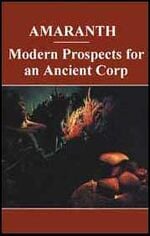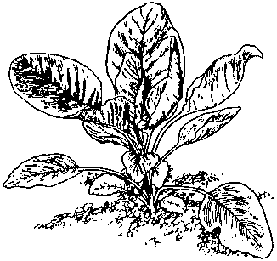Research Needs[edit | edit source]
As noted, amaranth research has been gaining momentum in recent years. While no fundamental obstacles to the crop's future development are apparent, many technical details remain to be explored. Agencies funding agricultural research for developing countries should consider supporting amaranth research and testing. Some recommendations and research needs are listed here.
COLLECTION AND SCREENING OF GERMPLASM
Amaranth offers more genetic diversity in its present undeveloped state than do many conventional crops. The broad geographic spread of the genus has resulted in the evolution of many land races in widely separated areas. Several features of their highly variable breeding system and overall reproductive biology provide ample choice of breeding methods.
This huge gene pool will be very important to the future development of the crop. The genetic characteristics of the types to be found there should be useful in amaranth-breeding programs worldwide, and it is best to have as many available as possible at this early stage in amaranth development. Further systematic collections of amaranth germplasm should be made in Latin America, the Caribbean, India, Nepal, China, and the Pacific.
These collections should be coordinated with the International Board on Plant Genetic Resources (IBPGR), which is starting germplasm collections in Southeast Asia and has recently completed one in Peru.
ADAPTABILITY TRIALS
Although a large number of accessions and progeny from breeding selections have already been screened in Pennsylvania, there has been no organized program to determine the relative adaptability of the better varieties elsewhere. Therefore, it is recommended that a cooperative research network be established in which perhaps 12 promising amaranth varieties are grown in 12 or more locations in different climates.
The varieties selected for adaptability trials should include a range of species and morphological types that have agronomic potential. This would be an excellent way to obtain indications of the geographical areas where given types will grow best. It would be the first step towards developing "zones" for amaranth adaptability, similar to those used for soybeans.
Larger trials, involving perhaps 100-500 varieties, should also be undertaken by geneticists and screening nurseries. Demonstration trials under farm conditions are also recommended.
ETHNOBOTANY OF THE CROP
Studies of the way people grow and use grain amaranths in Central and South America and the Himalayas, as well as those methods employed to grow and use vegetable amaranths elsewhere, could prove informative. Data could be gathered about the most favorable environments within which the various species can be grown. And much useful information could be collected by documenting the rainfall, temperature, daylength, and soil conditions of these areas. This would permit better targeting to new areas. It would also demonstrate:
- Lesser-known uses;
- Soil requirements;
- Crop ecology (for example, insect damage); and
- Social aspects of amaranth cultivation and use.
Although such studies will benefit those wanting to grow amaranth for the first time, it will also assist people who traditionally cultivate the crop.
WEEDY AMARANTHS
Seeds of the shattering, weedy amaranth species (for example, Amaranthus hybridus,
Amaranthus palmer), Amaranthus retroflexus, and Amaranthus spinosus) should not be distributed for cultivation. Nevertheless, these weeds can be useful to the amaranth breeder.
Amaranthus hybridus is the wild progenitor species of present-day cultivated Amaranthus hypochondriacus and easily exchanges genes with it. For introducing such desirable traits as faster maturation, disease resistance, and wider adaptability in the cultivated forms, the material of Amaranthus hybridus could be invaluable. And Amaranthus spinosus (a diploid), though sometimes a troublesome weed, can be utilized in raising hybrids (F1 triploids) with Amaranthus dubius (a tetraploid) on a commerical scale for forage. This is made possible by the peculiar distribution of male and female flowers in Amaranthus spinosus. The hybrids are fast growing, sterile, and have very soft spines. Feeding trials and nutritional studies are, however, a prerequisite before using such hybrids for forage.
AMARANTH TAXONOMY
A taxonomic "key" to amaranths compiled by Laurie Feine is available.
However, because amaranth taxonomy is so confused, a monograph on the family is needed.
SOME SPECIFIC RESEARCH NEEDS GRAIN AMARANTH GROWING PRACTICES
Amaranth cultivation and harvesting practices require several types of research. Many of the following items are site-specific.
- Selection of types best adapted to local conditions.
- Use of amaranth in mixed-cropping systems and rotation.
- Adaptation-it is important to learn the most extreme rainfall, evaporation, and soil characteristics under which amaranth can be grown and produce a reasonable yield.
- Soil requirements-fertility, tolerance for salinity, need for organic matter, and maximum and minimum moisture.
- Effects of growth conditions on chemical composition and nutritive value.
- Determination of best planting dates, plant density, and weed and pest management.
- Development or adaptation of machinery: planting implements, thresher, winnower, and grain cleaner.
- Control of diseases (for example, pythium and rhizoctonia fungi) and pests (such as Iygus bug).
- Storage of seeds (for example, the development of techniques to prevent "caking up," which makes planting more difficult).
DEVELOPING GRAIN AMARANTH VARIETIES
Breeding goals for grain amaranth include selection for:
- Desirable growth characteristics such as reduced plant size, reduced sensitivity to photoperiod, synchronous flowering, early maturity, reduced lodging, uniform drydown, reduced shattering, increased seed size, and high yield;
- Environmental adaptations such as drought tolerance, pest and disease resistance, herbicide tolerance, and efficient fertilizer utilization; and
- Food quality such as white seeds, palatability, and high levels of protein and essential amino acids.
GRAIN AMARANTH PROCESSING
Research is needed on the physiology of postharvest handling, especially on the effect of moisture on grain quality and storage. Also needed are studies on:
- Grain cleaning (especially for medium-scale pilot plants);
- Removal of sand and weed seeds from the grain;
- Adaptation of existing machinery to handle amaranth; and
- Drying and storage of harvested grain (unthreshed grain is hygroscopic).
Research is also needed on:
- Processing the whole grain, such as by extrusion cooking, milling whole and popped seed, and toasting, rolling, sprouting, and popping. Any changes in nutritional value or chemical compounds from such processing need to be assessed.
- Commercial development requirements, such as dry and wet milling, and derivatives (for instance, methylated and carboxy derivatives of amaranth starch).
- Siorage and shelf life of products.
- Value of the grain and crop residues for ensilage and for direct feeding to livestock.
GRAIN AMARANTH FOOD USES
Important research needs in the use of amaranth grain include:
- Basic characteristics of seed starch, protein, bran, germ, and oil;
- Uses in products, including breakfast foods and weaning mixtures, as well as recipe development;
- Nutritional testing in humans;
- Amaranth's value as a wheat extender or a supplement for added nutritional value in traditional foods such as chapaties, tortillas, weaning foods, chicha, and arepas;
- Use in infant foods;
- Nutritional availability of minerals, vitamins, protein, and starch;
- Amaranth's functional characteristics (viscosity, density, freezethaw stability, heat stability, emulsifying properties) when used in foods, and how grain types differ from one another; and
- Antinutritional constituents.
VEGETABLE AMARANTHS
Vegetable amaranths have been more thoroughly investigated than the grain amaranths.
Selections have been made by Asian growers for many years. Named varieties suitable for widespread culture are available from seed companies in Hong Kong, Taiwan, and the
United States (see Appendix C). Nevertheless, the crop could be improved by studies of:
- Pest and disease resistance;
- Nutrient uptake and nutrient content at different stages of harvest or crop growth;
- Leaf yield;
- Food quality, including tenderness and storage methods to prolong the life of the harvested produce;
- Use of amaranth leaves as a remedy for vitamin A deficiency;
- Antinutrition factors and heavy-metal accumulation in response to type and quantity of fertilizers used and type of soil;
- Production of leaf nutrient concentrate;
- Regrowth after harvest;
- Comparison of yield from clipping versus successive planting;
- Seed production and farmer-selection techniques;
- Leaf:stem ratio;
- Late emergence of inflorescences;
- Planting and cultural practices for efficient use of land, water, and fertilizer; and
- Crop rotation to avoid soil-borne diseases.
The benefits and possible toxic problems of vegetable amaranth as a forage also need study.
NEW USES
It is possible that amaranth products other than those described in this report could have important potential. Examples are:
- Natural dyes;
- Pharmaceuticals (for example, laxatives); and
- Squalene (a high-priced material found in amaranth seed but normally obtained from shark livers and used in cosmetics).
ENVIRONMENTAL EFFECTS
It is important to study the weediness of the most promising Amaranthus species and the likelihood of their becoming pests.
It is also possible that amaranth pollen and grain may cause undue allergic reactions in some people, and this needs to be assessed.
AMARANTHUS TRICOLOR

